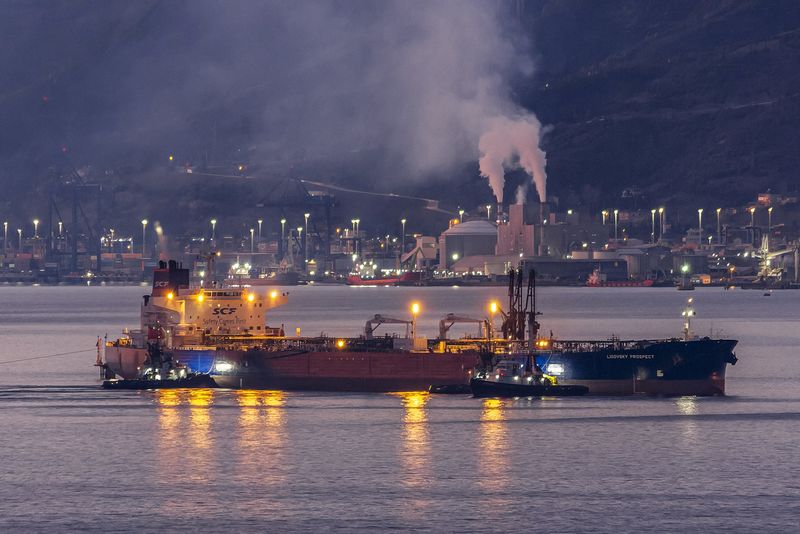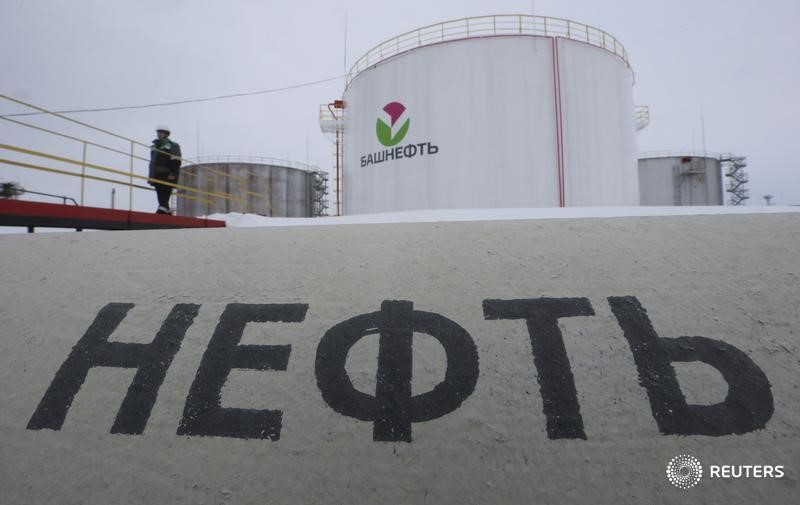By Nidhi Verma, Chen Aizhu, Siyi Liu and Florence Tan
NEW DELHI/SINGAPORE (Reuters) -Chinese and Indian refineries will source more oil from the Middle East, Africa and America, pushing up prices and freight costs, as new U.S. sanctions on Russian producers and ships cut off supplies to Moscow’s top customers. traders and analysts said.
The US Treasury Department on Friday imposed sanctions on Russian oil producers Gazprom (MCX:) Neft and Surgutneftegas, as well as 183 ships that have shipped Russian oil, targeting revenues Moscow has used to finance its war with Ukraine.
Many of the tankers have been used to ship oil to India and China as Western sanctions and a price ceiling imposed by the Group of Seven countries in 2022 shifted Russian oil trade from Europe to Asia. Some tankers have also shipped oil from Iran, which is also under sanctions.
Russian oil exports will be severely hit by the new sanctions, which will force Chinese independent refiners to cut refining output in the future, two Chinese trade sources said. The sources did not want to be named because they are not authorized to speak to the media.
The expected disruption to Russian supplies pushed global oil prices to their highest level in months on Monday, trading above $81 a barrel. [O/R]
Among the newly sanctioned ships are 143 oil tankers that carried more than 530 million barrels of Russian crude last year, about 42% of total seaborne crude exports, Matt Wright, Kpler’s chief cargo analyst, said in a note.
Of this, about 300 million barrels were shipped to China, while most of the rest went to India, he added.
“These sanctions will significantly reduce the fleet of ships available to deliver crude oil from Russia at short notice, driving up freight rates,” Wright said.
A Singapore-based trader said the designated tankers have shipped nearly 900,000 barrels of Russian crude per day to China over the past 12 months.
“It will fall off a cliff,” he added.
During the first eleven months of last year, India’s imports of Russian crude rose 4.5% year-on-year to 1.764 million barrels per day, or 36% of India’s total imports. Chinese volume, including pipeline supply, rose 2% to 99.09 million tonnes (2.159 million barrels per day) in the same period, or 20% of total imports.
China’s imports are mainly Russian ESPO Blend crude, which is sold above the price ceiling, while India mainly buys Ural oil.
Vortexa analyst Emma Li said that Russian exports of ESPO Blend crude oil would be halted if sanctions were strictly enforced, but that this would depend on whether newly-elected US President Donald Trump would lift the embargo and also whether China would recognize the sanctions.
ALTERNATIVES
The new sanctions will push China and India back into the compliant oil market as they seek more supply from the Middle East, Africa and America, the sources said.
Spot oil prices from the Middle East, Africa and Brazil have already risen in recent months due to rising demand from China and India as supplies of Russian and Iranian oil tightened and became more expensive, she added.
“Prices for Middle Eastern oils are already rising,” an Indian oil refinery official said.
“There is no other option than we should go for Middle Eastern oil. Maybe we should go for American oil too.”
A second Indian refining source said sanctions on Russian oil insurers will push Russia to price its crude below $60 a barrel so Moscow can continue to use Western insurance and tankers.
Harry Tchilinguirian, head of research at Onyx Capital Group said: “Indian refiners, the main buyers of Russian crude, are unlikely to wait to find out and will rush to find alternatives in the Middle East and Dated-Brent related crude oil from the Atlantic Basin.
“Strength in the Dubai benchmark can only increase from here as we are likely to see aggressive bidding for cargo loading from the likes of Oman or Murban in February, leading to a tighter spread between Brent and Dubai,” he added to it.

Last month, the Biden administration designated more ships handling Iranian crude ahead of tougher action expected from the incoming Trump administration, leading the Shandong Port Group to ban sanctioned tankers from calling at its ports in China’s eastern province doing.
As a result, China, the main buyer of Iranian crude, will also focus on heavier oil from the Middle East and most likely maximize its purchase of Canadian crude from the Trans-Mountain pipeline (TMX), Tchilinguirian said.


